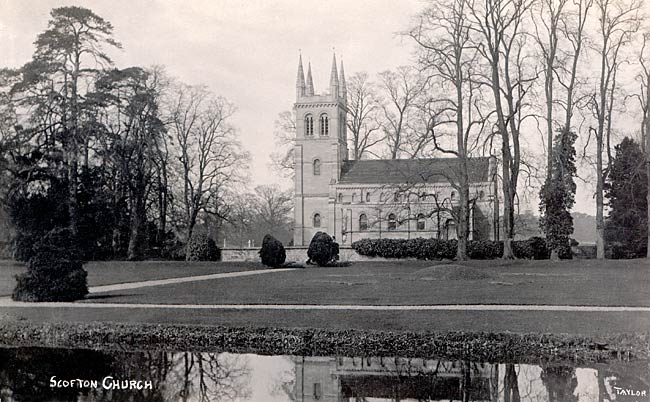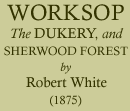< Previous | Contents | Next >
Hamlets in the parish of Worksop
Scofton and Hardwick
Scofton.

Scofton church, c.1910.
Separated from Osberton by the river Ryton, which is here expanded into the semblance of a broad stream, thus producing a most pleasing effect in the landscape when viewed in conjunction with its well-wooded margin, is Scofton, which though now merely an adjunct to the Hall of Osberton, was formerly a separate domain, with its resident proprietors. It is noted in the Domesday survey, together with Torp (unknown; perhaps Perlthorp) and Rouueton (Rayton), as an outlying member of the King’s manor of Mansfield. It is there written Scotebi, and the latter portion of which word, "by," seems to savour of there having been a settlement of Norsemen here in early times, as the former part appears to indicate that its first residents were derived from Scotland. We know, however, very little of the early history of this place.
Thoroton refers to a writ of false judgment in 21 Henry VIII., between Elizabeth Fenton, widow, against John Hill and others, concerning three messuages, 200 acres of land—40 of meadow, 20 of pasture, 4 of wood, and los. rent, with the appurtenances here, in the King’s Court of Mansfield, in Sherwood. He adds the prime capital messuage in Scofton hath for some time belonged to the Jessops.
These Jessops were of Broomhall, in the parish of Sheffield, which they inherited by marriage from the Swifts. The principal member of the family, who resided at Scofton, seems to have been Wortley Jessop, who was the heir of his house, but who died before his father, having been lost at sea in his passage from Ireland in 1617. He made his will at Scofton, April 13, 1615, which was proved before the Steward of the Manor of Mansfield, thus showing that the connection of Scofton with that court still existed.
After the Jessops, Scofton came into possession of Joseph Banks, who was in his early life a very eminent attorney at Sheffield, and agent to the Dukes of Norfolk, Leeds, and Newcastle. Mr. Banks soon acquired a large fortune, and became the purchaser of this place, where he came to reside, as well as of a large property at Reevesby Abbey, in Lincolnshire, where he was buried in 1727. He sat in one Parliament for Grimsby, and in another for Totness. He was the great grandfather of the Rt. Hon. Sir Joseph Banks, K.G.C. of the Bath, and Baronet, long president of the Royal Society.
Scofton next came into the hands of a branch of the Sutton family, it having been purchased by Brigadier Richard Sutton, a younger son of the ancient house of that name, and a resident at Avesham and Kelham in this county.
It is related, that some delay having arisen in delivering over the property to the General after his purchase, he, being mindful of the old adage that "possession is nine points of the law," and being in command of some troops in the neighbourhood, sent a body of men to take and occupy the Hall. Major-General Sutton died in August, 1737, and was buried at Avesham. He was succeeded by his eldest son Robert, whose grandson, Robert William Evelyn Sutton, Esq., of Scofton, sold the estate to the Foljambes. The Hall stood very near the site of the present church, and appears from drawings to have been a very pleasant residence. Besides the church, Scofton contains the kitchen gardens of Osberton Hall, together with part of the pleasure grounds, the head keeper’s residence, the schools, and a number of cottages; as also the well-regulated farm establishment, from whence of late so many sheep and oxen have gained prizes at our great National Agricultural Exhibitions.
Hardwick.

Estate cottages in Hardwick (photo: A P Nicholson, 2006).
This, again, is an ancient hamlet of Worksop Parish, distant about four miles from the town to the South East, situated a mile from Clumber House, near the head of the lake.
It is not mentioned in the Domesday survey, but, no doubt, it formed part of one of the two manors there said to have existed before the conquest in Clumber. These, after that event, became part of the fee of Roger de Bush, and not long subsequently were subin-feuded, or at least much of them, to the family of Lovetot, together with the manor of Worksop, &c. Richard de Lovetot, the son of the founder of the Priory of Worksop, by his charter confirmed the gifts of his father to that monastry, among other things, of "two bovates of land in Herthwik at Utware," so designated to distinguish it from another ware (weir) or dam, no doubt for the supply of a mill in Worksop called Inware, in these charters. A mill is noted in Domesday as pertaining to one of the manors at Clumber. Matilda de Lovetot, the great heiress of the family, confirms the grant of her ancestors of "the whole village of Herthwik."
It thus had become the property of Worksop Priory; and in the 14th Edward I. a charter of free warren was granted to the Prior of that house in this place, as well as in Shireoaks. Nothing further appears to be known of its history till the time of the dissolution of monastries, when, in the " Valor Ecelesiasticus" of the 26th Henry VIII., it is mentioned with property at Osberton, with which it then went, also at Clumber and Haughton—thus "The graunge of Osberton, iij£., Hardwyk Walke Mylne, xxvjs. viijd.; rent of Haugh, vijs. vjd., Hardwyk Graunge, iij£., and Clumber Graunge, xiijs. iiijd. These two latter granges may not improbably have represented the two old Saxon manors. It was granted 3rd July, 32 Henry viii., together with Osberton Grange and other property, to Robert Dighton, Esq., and his heirs, who shortly afterwards obtained a licence to alienate Hardwick Grange and wood, with all houses, &c., in Osberton and Hardwick, and Worksop, to Richard Whalley, and his heirs; and all messuages, lands, and other houses in Osberton Grange, Hardwick, &c., to William Bolles, and his heirs. From some or other of their representatives it was acquired, it is presumed by purchase, by the ancestors of the present noble proprietor, and has since formed a part of the estates of Haughton and Clumber. Here the home-farm of Clumber House has long been situated; and the late Duke of Newcastle, from a humane consideration for his labourers, many of whom lived at a distance, erected a group of cheerful and comfortable cottages.
As already stated, Hardwick stands at the head of Clumber Lake, which from this point, its best view, presents a. very fine expanse of water, with well-wooded margins. These different objects, with the house seen in the distance, form altogether a very pleasing landscape.

